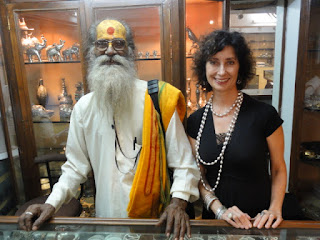 |
| Image of Buddha at Mahadbodhi temple. |
Our group was short on time so we went directly Bodhgaya. It was closed. As fate would have it, the crown prince of Thailand a f rom all over Asia including Japan Korea Bhutan Tibet
Upon entering the grounds I saw the Mahadbodhi temple on the spot of a temple originally built in the first BC. THE tree was behind it. In honor of the crown prince's visit this magnificent temple was all tarted up with golden bows made of flowing fabric, artificial lotus flowers, fake cherry trees in full blossom and glitter encrusted Styrofoam peacocks. I would have much preferred the undecorated version. Within the temple is a golden statue of the Buddha accessible through a small doorway. There was much pushing and shoving to see this image of the enlightened one. I blocked a group of pilgrims from running over the senior citizen French lady in front of me. What would Buddha say?
 |
| Leaves of the Bhodi tree. |
We made our way to the back of the temple to see the Bodhi tree, which is said to be a sapling of the original. This beloved tree was surrounded by chanting and frequently dour-faced pilgrims, its heavy sprawling branches providing shade to followers, monks and tourists alike. Behind iron gates a silver throne marked the spot where the Buddha sat. I tried in vain to imagine the Buddha there. It was too crowded. I took pictures. Around the side of the temple were stepping stones imprinted with beautiful golden lotuses and placed in spots where Buddha took his first steps after enlightenment.
 |
| A monk sifting through meditation beads. |
Around the perimeter of the grounds was another tree where monks from the monasteries come on a daily basis to meditate, chant, read and prostrate themselves. They have simple elevated wood palates covered with prayer rugs. One monk meditatively sifted through prayer beads. Another monk was looking at his cell phone while his family visited. A mongrel made his way among them, wagging his tail.
I looked for a quiet place and found one structure empty of people. It housed several stone carved statues of Buddha. Votives and incense burned on a small alter. The statues looked perfectly serene. I had a f ew minutes to sit before leaving.
On the way out there was a deluge of souvenir sellers. I didn't want a Bodhi tree leaf in a plastic baggie or a string of plastic prayer beads. I just wanted to take away the sense of peace I felt in the room of silent Buddhas.

















